Dubrovnik, Pearl of the Adriatic
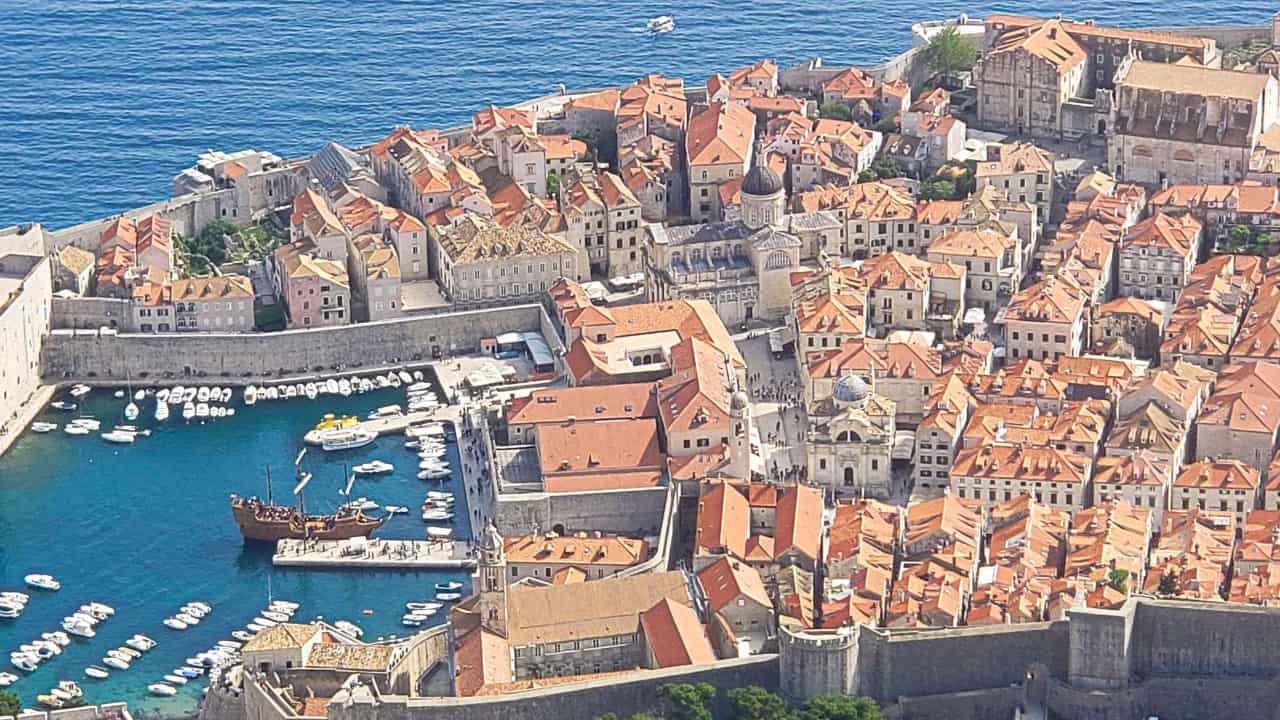
George Bernard Shaw, visiting Dubrovnik in 1929 said: “If you want to see heaven on earth, come to Dubrovnik.” Lord Byron coined the phrase “Pearl of the Adriatic” when describing Dubrovnik. My apologies for the length of this article but given the history, culture, and scenery in this area I didn’t know how to shrink it.
We have just spent 8 days enjoying Dubrovnik and the surrounding area. Dubrovnik is a must see if you are ever in this part of the world. It is a little over-run with tourists, and they are now limiting the cruise ships scheduled to dock in the harbour, but it is lovely. Dubrovnik was founded in the 7th century. The famous walls around the city, constructed mainly during the 12th–17th centuries, run for 2 km and have been highlighted in many films. The fictional city of King’s Landing from the “Game of Thrones” is actually Dubrovnik. Most recently Dubrovnik was showcased in Star Wars: Episode VIII and Robin Hood: Origins, produced by Leonardo DiCaprio.
The walls are up to six metres thick in places and have never been breached by a hostile army. When Dubrovnik was lost to the French, Napoleon’s troops had been invited into the city.
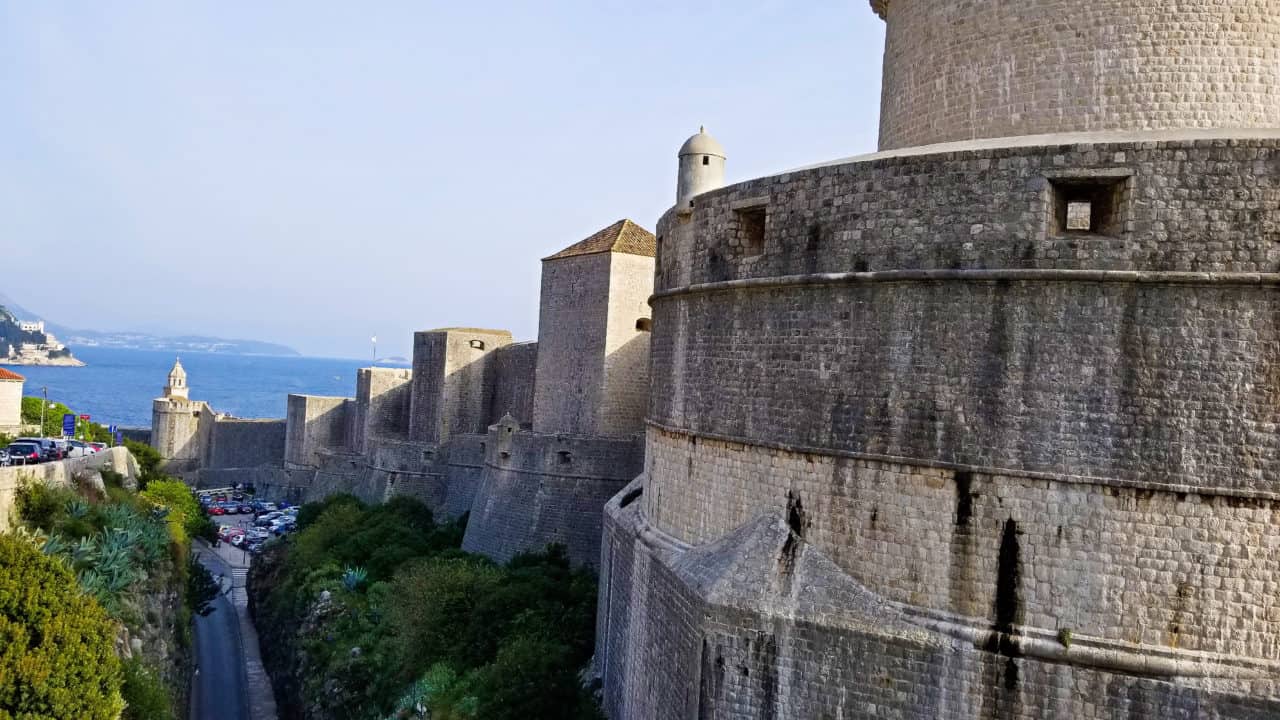
The city was largely destroyed in the 16th century due to a major earthquake. At this time all visitors entering the city had to bring a stone; large people had to bring large rocks and smaller people brought smaller stones, all to be used for rebuilding. I have read about this happening in other places, but I can’t remember where. Following attacks on the city during Croatia’s War of Independence from Yugoslavia (more on that below), Dubrovnik had to be repaired. Many of the damaged buildings are clearly visible from high points around the city in the form of the more brightly coloured new roofs. Today, thanks to sandblasting, much of the town looks almost brand-new, maybe too new. Walking around this medieval city is just stunning. In 1979, the city of Dubrovnik joined the UNESCO list of World Heritage sites. It is fantastic to see but it is a tourist destination not somewhere you would just drop in to visit in the evenings if you lived nearby. Given the crowds we saw in April, I cannot imagine what it is like in August.
Dubrovnik makes it money from tourism, and it is the most expensive place we have been on our three-year voyage so far. Here are just a few examples. Cappuccinos in Croatia are typically $1 – $2 but in Dubrovnik you get two of them for $14. I peaked at the menu in a Japanese restaurant and a California Roll was $30. Our camping neighbours told us that they ate one meal in Dubrovnik and that did in their food budget for a very long time.
$80 (CDN) would get the two of us; a walk on the city walls, or a tour of one of the buildings in the city, or 4 hours of parking at a nearby hotel. Parking a little further out, about a 10 or 15-minute walk up and down hill to Old Dubrovnik cost us $16 for the afternoon. When we went further out, near a mall in modern Dubrovnik it cost about $2/hr. What a huge difference.
There are some good deals. Ice cream cones are only $3. Mike and I went on a small boat with six other people for 45 minutes around the city. This cost us $15 each. We sat next to the boat pilot and had a great conversation with him. He told us that before the war in 1991/1992 more than 5,000 people lived in the Old Town and today it is less than 1,500 with very few of these being children. He moved his entire family, who had been living in Old Dubrovnik for many generations, out of the city. He said that there was one little grocery store in town, parking, if you could find a spot, was really expensive and that there was a constant smell of cooking oil. Mike had already told me that he thought Dubrovnik was one large restaurant with multiple kitchens. Everywhere you looked where people sitting under umbrellas eating really expensive meals.
This week was part of Dubrovnik’s music festival. On Tuesday night the Dubrovnik Symphony Orchestra was holding a free concert in the cathedral. I put it on our calendar. We were out all Tuesday and didn’t get back until almost 6pm. It was raining hard and available parking is normally a 15-minute walk downhill to the cathedral. If we had purchased tickets we would have gone without question. Since it was free (how unusual) and you couldn’t get reserved seats and we were pretty tired, we decided to give it a miss. Even when we were making that decision, I knew that I would regret it.
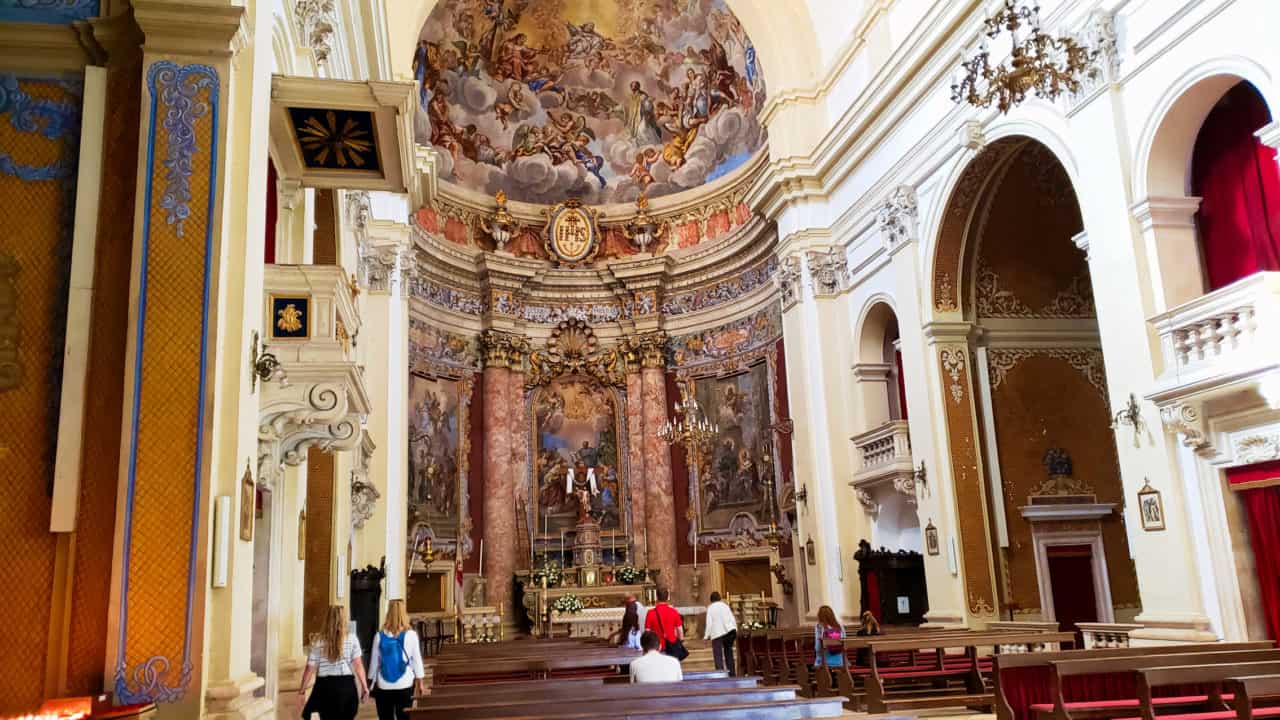
The boat pilot also told us that a few years ago you could go out on a boat and see dolphins almost every day. Now you are lucky if you can see them early in the morning or at sunset. He doesn’t know what has changed but something obviously has. He told us about a pharmacy from the 13th century in the city of Dubrovnik (outside the walls) that is still a pharmacy today. Apparently, it is the third-oldest European pharmacy and the oldest still in operation
In 1296, the Dubrovnik Republic built one of the first medieval sewage systems which, according to the internet, is still being used today, hopefully with some upgrades. Dubrovnik streets were designed with a slope to carry away rain water. Septic tanks and channels were constructed for the removal of dirty water. All septic tanks were built underneath the house or street and had to be cleaned every ten years at the expense of the owner, so that they would not overflow. Remember, this was when Paris and London were still throwing their sewage out the windows. In 1438 a 20 km (12 mi) water supply system was constructed. The list of the firsts that came from this Republic is just amazing.
The first quarantine hospital in the world was set up in Dubrovnik in 1377. Like the sewage system, this was to help prevent the spread of diseases such as cholera and yellow fever.
Over 600 years ago, Dubrovnik was the first country in Europe to abolish slavery, hundreds of years before much of the world including Britain and the US. They condemned slavery as “shameful, wrong and disgusting, and against all humanity”’
A few other interesting facts; the Republic opened one of the first orphanages in 1432, they were the first country in the world to recognize the United States in 1783, the Republic of Dubrovnik was also known as the Republic of Ragusa.
Mike and I explored both the Old Town of Dubrovnik and the surrounding smaller towns in the region. We saw one complex consisting of multiple, very large hotels and a shopping area that was deserted and falling down. There is no glass in the windows anywhere and there’s graffiti everywhere. In the picture below, every building is abandoned. Apparently during the war this complex was inhabited by the Yugoslav army and was possibly bombed although we didn’t see any evidence of that. After the army left the entire complex stayed empty and went to ruins. Other properties that were used during the war were brought back to life. The prime location, right on the sea and only about 5 km from Dubrovnik make it very surprising that is was never restored. Rumour has it that something is in the works for this location. By the way, when you hear the term “the war” in Croatia it refers to the Croatian War of Independence or the Homeland War in 1991/1992 and not either of the World Wars. How recent that must still feel to Croatians.
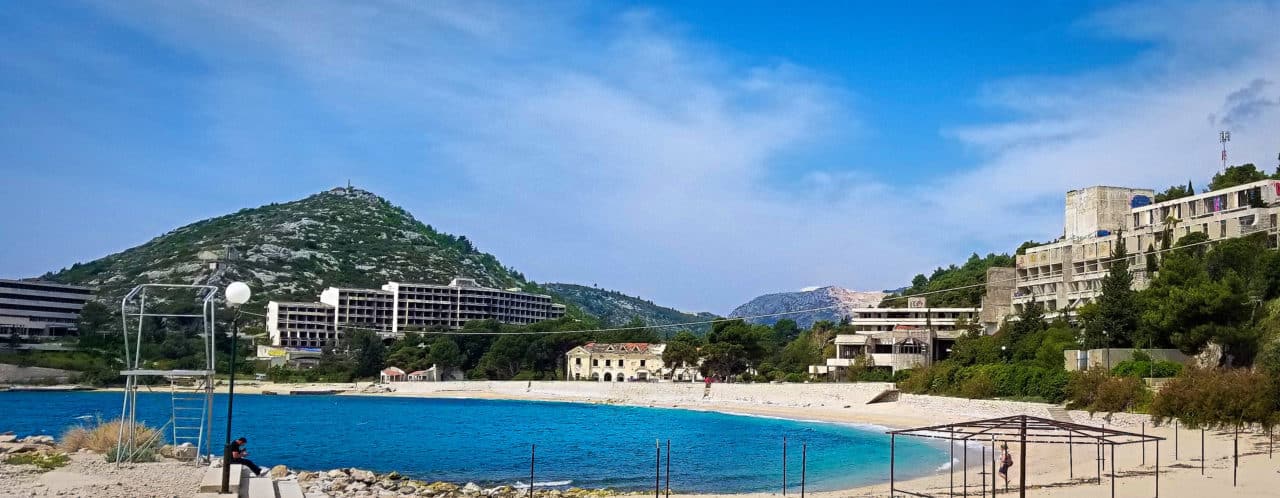
The first day we visited Dubrovnik we saw a cable car running up a small mountain/hill to a fort overlooking the city. When we returned two days later the cable car was shut down due to a financial disagreement with the city. We discovered that you could drive up a skinny road with the car. If a car met a bicycle, they both stopped and one just inched forward trying to pass the other without falling off the mountain. This was a two-way road with traffic going both up and down the mountain. It was tricky and uncomfortable. Part of the old fort at the top is now a museum about the 1991/92 war. It was quite well done. From the fort you had the most gorgeous views of the entire walled city of Dubrovnik as you can see at the top of this page. It was unbelievable.
The fort was built by Napoleon when he invaded Dubrovnik and our boat pilot, to this day, is still livid if you mention Napoleon. On the other side the fort helped Dubrovnik tremendously during “the war”.
Mike and I leave Dubrovnik tomorrow. Seeing this city has been fascinating. I am very glad that we are not here in high season.
For anyone not very interested in history, you can stop here. I hated history in school, and I won’t make others read it. What a different perspective you get when you travel extensively and see these medieval cities and talk with people who lived under Russian and German occupation or who only got their independence 30 years ago. Below is some of the local history, most relatively recent, that I found quite interesting.
** note: Picture group removed due to licensing issues
History of Republic of Dubrovnik
Dubrovnik’s prosperity was based on maritime trade and on being major trade mediators or diplomats. Dubrovnik was notable for its wealth particularly during the 15th and 16th centuries. As mediators and diplomats Dubrovnik remained neutral during the many European wars.
There was a major earthquake in the 1600s that levelled much of Dubrovnik and killed over 5,000 citizens. This negatively impacted the well-being of the whole Republic.
In 1699, the Republic was forced to sell two mainland patches of its territory to the Ottomans in order to avoid being caught in the clash with advancing Venetian forces. This is the strip of land that I mentioned in my last article which now is part of Bosnia and Herzegovina.
In 1797 Napoleon seized Venice, Dubrovnik’s major rival in trade and diplomacy. A few years later, while Napoleon was fighting the Russians, a few of his troops asked for shelter in Dubrovnik on their way to Montenegro. Napoleon promised not to occupy the territory and stressed that the French were friends of Dubrovnik. The few troops in the city were immediately followed by an invasion force that blockaded the harbour and took over Dubrovnik. With the walls still standing, in 1806 Dubrovnik fell to Napoleon’s army and the Republic of Dubrovnik disappeared from Europe after several centuries of independence.
After the Balkan Wars of 1912–13 ended Ottoman rule in the Balkan Peninsula and Austria-Hungary was defeated in World War I, the Paris Peace Conference created the Kingdom of Serbs, Croats, and Slovenes which later became known as the Kingdom of Yugoslavia. After Tito’s death on 4 May 1980, ethnic tensions escalated in Yugoslavia.
In 1991, Slovenia and Croatia declared their secession from the Yugoslav federation. Slovenia, after only the Ten-Day War, managed to gain their independence.
In the early 1970s Dubrovnik had demilitarized. It was renowned in the world as a city of culture and art. There was an illusion that due to these facts and as a UNESCO site, under UNESCO’s protection Dubrovnik would be spared destruction in case of war. This was not to be. The Croatian War of Independence started in 1991. The Old Town of Dubrovnik sent out a notice to Croats whose homes had been bombed etc. that they could find refuge in Dubrovnik.
Later in 1991 and into 1992 Dubrovnik came under siege for nearly eight months by the Yugoslav People’s Army. The artillery attacks on Dubrovnik damaged 56% of its buildings to some degree. In addition to its own citizens, all the people that had sought shelter there had to be evacuated. During the Croat quest for independence large Serb communities within Croatia rebelled. They did not want to be demoted to the status of a national minority in a sovereign Croatia.
The Croatian Army lifted the siege in May 1992, and liberated Dubrovnik’s surroundings by the end of October, but the danger of sudden attacks from the Yugoslav army lasted for another three years
Following the end of the war, damage caused by the shelling of the Old Town was repaired. Adhering to UNESCO guidelines, repairs were performed in the original style. After repair and restoration Dubrovnik has re-emerged as one of the top tourist destinations in the Mediterranean.
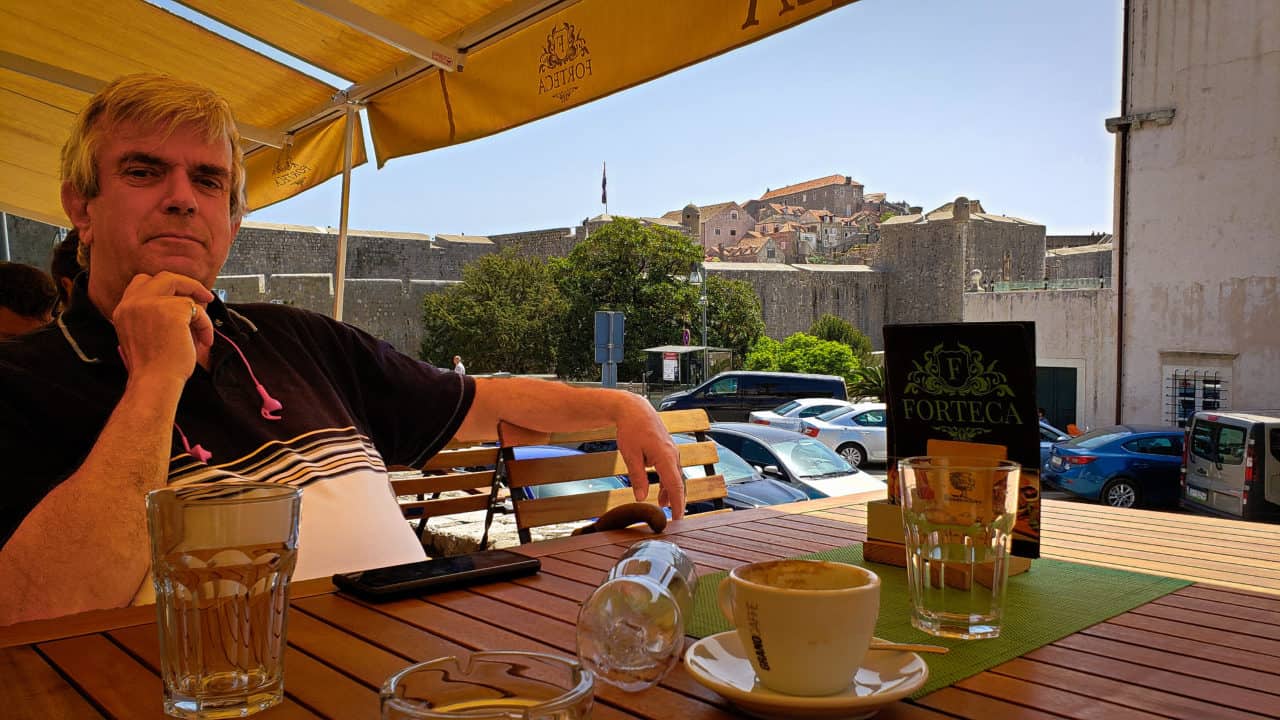

Leave a Reply